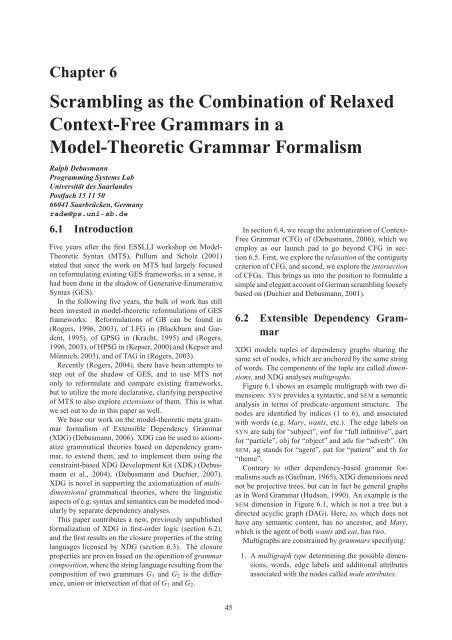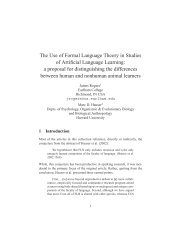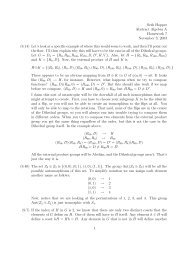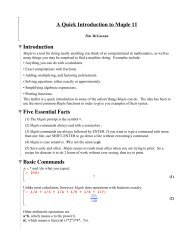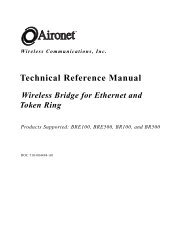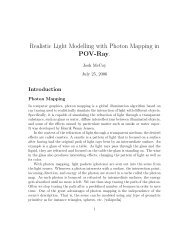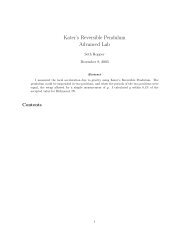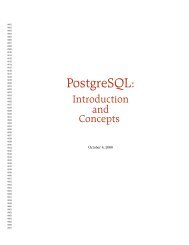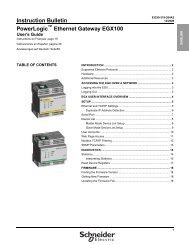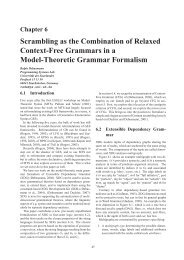Model-Theoretic Syntax at 10 - Earlham Computer Science ...
Model-Theoretic Syntax at 10 - Earlham Computer Science ...
Model-Theoretic Syntax at 10 - Earlham Computer Science ...
You also want an ePaper? Increase the reach of your titles
YUMPU automatically turns print PDFs into web optimized ePapers that Google loves.
Chapter 6<br />
Scrambling as the Combin<strong>at</strong>ion of Relaxed<br />
Context-Free Grammars in a<br />
<strong>Model</strong>-<strong>Theoretic</strong> Grammar Formalism<br />
Ralph Debusmann<br />
Programming Systems Lab<br />
Universität des Saarlandes<br />
Postfach 15 11 50<br />
66041 Saarbrücken, Germany<br />
rade@ps.uni-sb.de<br />
6.1 Introduction<br />
Five years after the first ESSLLI workshop on <strong>Model</strong>-<br />
<strong>Theoretic</strong> <strong>Syntax</strong> (MTS), Pullum and Scholz (2001)<br />
st<strong>at</strong>ed th<strong>at</strong> since the work on MTS had largely focused<br />
on reformul<strong>at</strong>ing existing GES frameworks, in a sense, it<br />
had been done in the shadow of Gener<strong>at</strong>ive-Enumer<strong>at</strong>ive<br />
<strong>Syntax</strong> (GES).<br />
In the following five years, the bulk of work has still<br />
been invested in model-theoretic reformul<strong>at</strong>ions of GES<br />
frameworks. Reformul<strong>at</strong>ions of GB can be found in<br />
(Rogers, 1996, 2003), of LFG in (Blackburn and Gardent,<br />
1995), of GPSG in (Kracht, 1995) and (Rogers,<br />
1996, 2003), of HPSG in (Kepser, 2000) and (Kepser and<br />
Mönnich, 2003), and of TAG in (Rogers, 2003).<br />
Recently (Rogers, 2004), there have been <strong>at</strong>tempts to<br />
step out of the shadow of GES, and to use MTS not<br />
only to reformul<strong>at</strong>e and compare existing frameworks,<br />
but to utilize the more declar<strong>at</strong>ive, clarifying perspective<br />
of MTS to also explore extensions of them. This is wh<strong>at</strong><br />
we set out to do in this paper as well.<br />
We base our work on the model-theoretic meta grammar<br />
formalism of Extensible Dependency Grammar<br />
(XDG) (Debusmann, 2006). XDG can be used to axiom<strong>at</strong>ize<br />
gramm<strong>at</strong>ical theories based on dependency grammar,<br />
to extend them, and to implement them using the<br />
constraint-based XDG Development Kit (XDK) (Debusmann<br />
et al., 2004), (Debusmann and Duchier, 2007).<br />
XDG is novel in supporting the axiom<strong>at</strong>iz<strong>at</strong>ion of multidimensional<br />
gramm<strong>at</strong>ical theories, where the linguistic<br />
aspects of e.g. syntax and semantics can be modeled modularly<br />
by separ<strong>at</strong>e dependency analyses.<br />
This paper contributes a new, previously unpublished<br />
formaliz<strong>at</strong>ion of XDG in first-order logic (section 6.2),<br />
and the first results on the closure properties of the string<br />
languages licensed by XDG (section 6.3). The closure<br />
properties are proven based on the oper<strong>at</strong>ion of grammar<br />
composition, where the string language resulting from the<br />
composition of two grammars G 1 and G 2 is the difference,<br />
union or intersection of th<strong>at</strong> of G 1 and G 2 .<br />
In section 6.4, we recap the axiom<strong>at</strong>iz<strong>at</strong>ion of Context-<br />
Free Grammar (CFG) of (Debusmann, 2006), which we<br />
employ as our launch pad to go beyond CFG in section<br />
6.5. First, we explore the relax<strong>at</strong>ion of the contiguity<br />
criterion of CFG, and second, we explore the intersection<br />
of CFGs. This brings us into the position to formul<strong>at</strong>e a<br />
simple and elegant account of German scrambling loosely<br />
based on (Duchier and Debusmann, 2001).<br />
6.2 Extensible Dependency Grammar<br />
XDG models tuples of dependency graphs sharing the<br />
same set of nodes, which are anchored by the same string<br />
of words. The components of the tuple are called dimensions,<br />
and XDG analyses multigraphs.<br />
Figure 6.1 shows an example multigraph with two dimensions:<br />
SYN provides a syntactic, and SEM a semantic<br />
analysis in terms of predic<strong>at</strong>e-argument structure. The<br />
nodes are identified by indices (1 to 6), and associ<strong>at</strong>ed<br />
with words (e.g. Mary, wants, etc.). The edge labels on<br />
SYN are subj for “subject”, vinf for “full infinitive”, part<br />
for “particle”, obj for “object” and adv for “adverb”. On<br />
SEM, ag stands for “agent”, p<strong>at</strong> for “p<strong>at</strong>ient” and th for<br />
“theme”.<br />
Contrary to other dependency-based grammar formalisms<br />
such as (Gaifman, 1965), XDG dimensions need<br />
not be projective trees, but can in fact be general graphs<br />
as in Word Grammar (Hudson, 1990). An example is the<br />
SEM dimension in Figure 6.1, which is not a tree but a<br />
directed acyclic graph (DAG). Here, to, which does not<br />
have any semantic content, has no ancestor, and Mary,<br />
which is the agent of both wants and e<strong>at</strong>, has two.<br />
Multigraphs are constrained by grammars specifying:<br />
1. A multigraph type determining the possible dimensions,<br />
words, edge labels and additional <strong>at</strong>tributes<br />
associ<strong>at</strong>ed with the nodes called node <strong>at</strong>tributes.<br />
45


